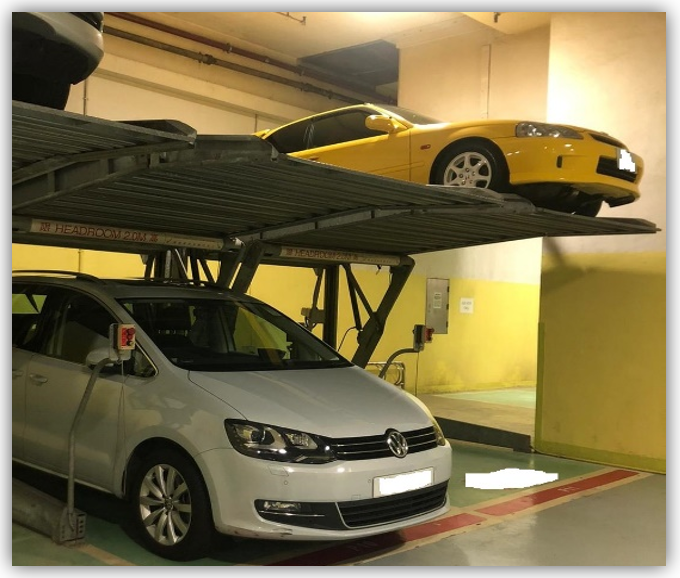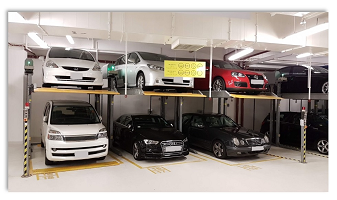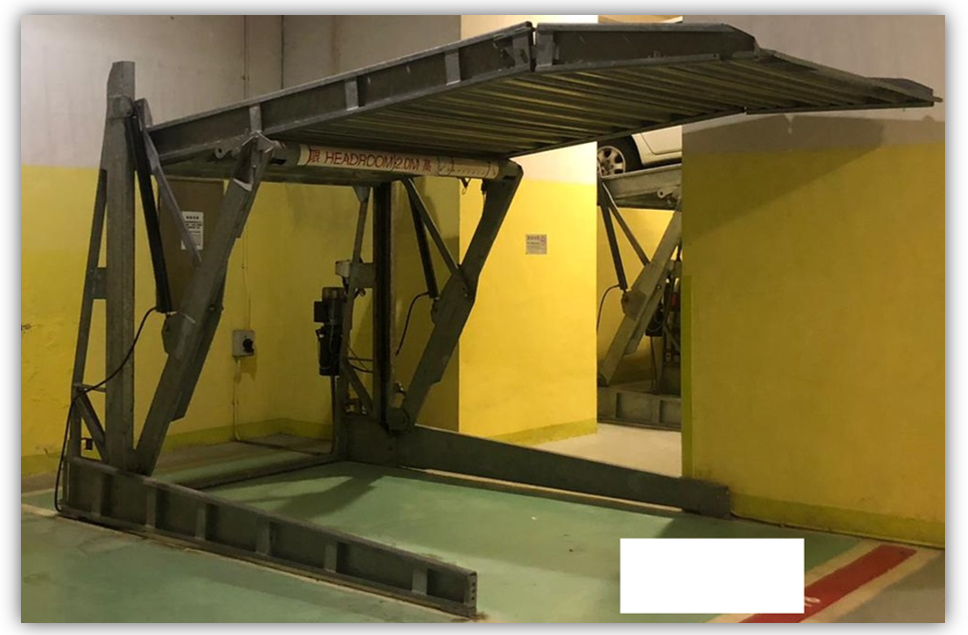Guide to Safety on Double-Deck Car Park
Scope of Application
 These guidelines are only applicable to double-deck car parks (commonly known as car stackers [1]) used solely for the raising of motor vehicles, which do not pass through any floor and the height of travel of which do not exceed 3.5m.
These guidelines are only applicable to double-deck car parks (commonly known as car stackers [1]) used solely for the raising of motor vehicles, which do not pass through any floor and the height of travel of which do not exceed 3.5m.
Mechanized vehicle parking systems not satisfying the condition above are subject to the control of the Lifts and Escalators Ordinance (Cap. 618).
The double-deck car park normally has two parking spaces, one above the other. The vehicle in the lower parking space has to be removed in order to allow lowering of the platform at the upper stop position.
Building Requirements
 Prior to the commencement of works every person for whom the installation of a double-deck car park is to be carried out shall appoint an authorized person or a registered structural engineer. Such appointed person should submit to the Building Authority the proposal together with corresponding structural justification demonstrating the stability of the double-deck car park and structural adequacy of the building in which the car park is to be installed.
Prior to the commencement of works every person for whom the installation of a double-deck car park is to be carried out shall appoint an authorized person or a registered structural engineer. Such appointed person should submit to the Building Authority the proposal together with corresponding structural justification demonstrating the stability of the double-deck car park and structural adequacy of the building in which the car park is to be installed.
General Requirements
- Owners and facility management personnel of the double-deck car parks are liable for the proper upkeep and safe working order of the equipment [2].
- Safe and adequate access to the platform controls must be provided for the operator/user.
- Adequate electricity supply is available for operation of the double-deck car park.
- If the double-deck car park is installed in the open area, the equipment including the electrical components should be of a design suitable for outdoor environment.
- The double-deck car park is prohibited from being used to lift persons or vehicles with persons.
Safety Features
Mechanical Locks
The platform holding the motor vehicle shall be mechanically locked automatically when it reaches the upper stop position. A visual indication or audible signal will be given, if the platform has not reached the upper or lower stop position or has not been mechanically locked.
Overload Device
Unless there are other means to prevent lifting a motor vehicle exceeding the capacity of the platform/equipment, an overload device should be installed to prevent any movement of the platform and to give an alarm when the load on the elevating platform is in excess of the rated capacity.
Deadman Control
The movement of the platform shall be stopped, unless the operator keeps his hand on the local control device during the raising or lowering process.
Key Switch
A key-locked switch to avoid any unauthorised operation should be provided.
Chocks
Automatic or permanent chocks shall be provided to arrest any unpowered movement of the vehicle on the platform.
Emergency Operation
A device shall be provided to lower the platform when the normal power supply fails.
Operation and Maintenance
- Do not use the platform to raise over-sized or over-weight vehicles. Notice in Chinese and English stipulating the safe working load and maximum allowable vehicle size should be displayed.
- Do not allow children playing with the operation of the platform. If the double-deck car park is not in operation, take away the key from the control panel to avoid tampering.
- The platform shall not be lowered when the lower deck is occupied. The floor area directly beneath the platform should be clearly marked.
- A competent service provider should be engaged for undertaking maintenance on the double-deck car parks. Regular maintenance/checks on equipment should be conducted at intervals as recommended by the manufacturer.
- A Registered Professional Engineer (RPE) of a suitable discipline (e.g. mechanical, marine etc.) should be engaged for undertaking examination on the double-deck car parks and certifying the equipment to be in safe working order on an annual basis.
These guidelines are issued by General Legislation Division of Electrical and Mechanical Services Department. Compliance with these guidelines does not of itself confer immunity from any legal obligation.
Mechanized Vehicle Parking Systems
These guidelines are only applicable to double-deck car parks (commonly known as car stackers [1]) used solely for the raising of motor vehicles, which do not pass through any floor and the height of travel of which do not exceed 3.5m.
 Prior to the commencement of works every person for whom the installation of a double-deck car park is to be carried out shall appoint an authorized person or a registered structural engineer. Such appointed person should submit to the Building Authority the proposal together with corresponding structural justification demonstrating the stability of the double-deck car park and structural adequacy of the building in which the car park is to be installed.
Prior to the commencement of works every person for whom the installation of a double-deck car park is to be carried out shall appoint an authorized person or a registered structural engineer. Such appointed person should submit to the Building Authority the proposal together with corresponding structural justification demonstrating the stability of the double-deck car park and structural adequacy of the building in which the car park is to be installed.